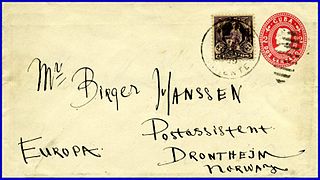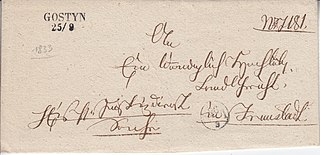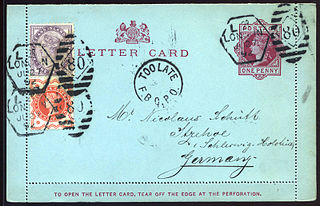
A cancellation is a postal marking applied on a postage stamp or postal stationery to deface the stamp and prevent its re-use. Cancellations come in a huge variety of designs, shapes, sizes and colors. Modern cancellations commonly include the date and post office location where the stamps were mailed, in addition to lines or bars designed to cover the stamp itself. The term "postal marking" sometimes is used to refer specifically to the part that contains the date and posting location, although the term often is used interchangeably with "cancellation." The portion of a cancellation that is designed to deface the stamp and does not contain writing is also called the "obliteration" or killer. Some stamps are issued pre-cancelled with a printed or stamped cancellation and do not need to have a cancellation added. Cancellations can affect the value of stamps to collectors, positively or negatively. The cancellations of some countries have been extensively studied by philatelists and many stamp collectors and postal history collectors collect cancellations in addition to the stamps themselves.

A stamped envelope or postal stationery envelope (PSE) is an envelope with a printed or embossed indicium indicating the prepayment of postage. It is a form of postal stationery.

The Far Eastern Republic, sometimes called the Chita Republic, existed from April 1920 to November 1922 in the easternmost part of Siberia. It was formed from the Amur, Transbaikal, Kamchatka, Sakhalin, and Primorye regions. In theory, it extended from Lake Baikal to Vladivostok but, in May 1921, the Priamur and Maritime Provinces seceded. Although nominally independent, it was largely controlled by the RSFSR and its main purpose was to be a democratic buffer state between the RSFSR and the territories occupied by Japan during the Russian Civil War to avoid war with Japan. Initially, its capital was Verkhneudinsk, but from October 1920 it was Chita. On 15 November 1922, after the war ended and the Japanese withdrew from Vladivostok, the Far Eastern Republic was annexed by Soviet Russia.

The postage stamps and postal history of Israel is a survey of the postage stamps issued by the state of Israel, and its postal history, since independence was proclaimed on May 14, 1948. The first postage stamps were issued two days later on May 16, 1948. Pre-1948 postal history is discussed in postage stamps and postal history of Palestine.

The postal history of Turkey and its predecessor state, the Ottoman Empire, dates to the 18th century when foreign countries maintained courier services through their consular offices in the Empire. Although delayed in the development of its own postal service, in 1863 the Ottoman Empire became the second independent country in Asia to issue adhesive postage stamps, and in 1875, it became a founding member of the General Postal Union, soon to become the Universal Postal Union. The Ottoman Empire became the Republic of Turkey in 1923, and in the following years, its postal service became more modernized and efficient and its postage stamps expertly designed and manufactured.
Soviet Union stamp catalogue is a national catalogue of the RSFSR and USSR postage stamps and miniature sheets, which was being published in the USSR by the “Soyuzpechat” Central Philatelic Agency (CPA) and some other publishers related to the Ministry of Communications. The catalogue usually republished in corpore around once in a 10–15 years. In between republications, additional issues came out every year. These issues contains descriptions of stamps and miniature sheets issued in USSR last year.
The Ruch catalog of postage stamps of Poland, officially titled Ilustrowany Katalog Znaczków Polskich, contains detailed information on Polish postage stamps, and was published on a yearly basis.
The China Stamp Society is a philatelic organization dedicated to the appreciation of the postage stamps and postal history of China, including the Treaty Ports, Foreign Offices in China, the Japanese Occupation, Hong Kong, Macao, Manchukuo and Tibet.

This is a survey of the postage stamps and postal history of the Czech Republic.

This is a survey of the postage stamps and postal history of Czechoslovakia.

This is a survey of the postage stamps and postal history of Liechtenstein.

This is a survey of the postage stamps and postal history of the Netherlands.

Janusz Marja Stefan Rogala Kaluski (1924–2010) was a sapper in the Polish Army who took part in the D-Day landings of World War II and who later won the Cross of Valour. In later life, Kaluski devoted himself to the philately of Poland, eventually becoming a Fellow of the Royal Philatelic Society London and donating his stamp collection of fifty years to the British Library Philatelic Collections in 2003.

This is a survey of the postage stamps and postal history of Nova Scotia.

This is a survey of the postage stamps and postal history of the Ryukyu Islands.
The Kaluski Collection is a collection of stamps of Poland that forms part of the British Library Philatelic Collections. It was formed by Janusz Kaluski and donated to the library in 2003 and includes 46 volumes detailing the stamps and postal history material of Poland from 1835 to 2002.

A local postal service briefly operated in the Polish town of Żarki during the month of October 1918. Postage stamps were issued, in one design but in three denominations denoted by different colouring. A set of forgeries was made in 1928. The stamps, both genuine and forged, have attracted philatelic attention.
















